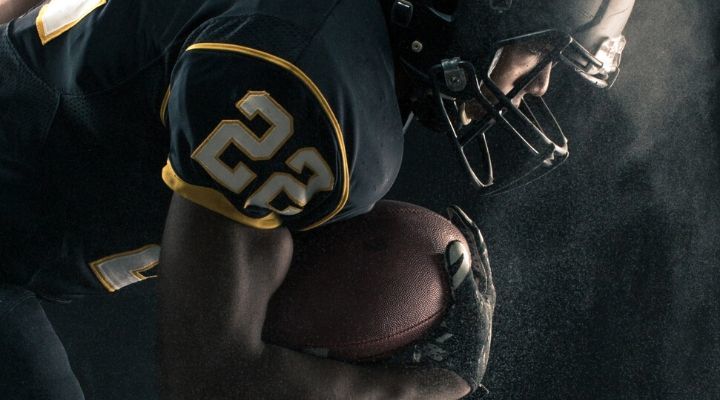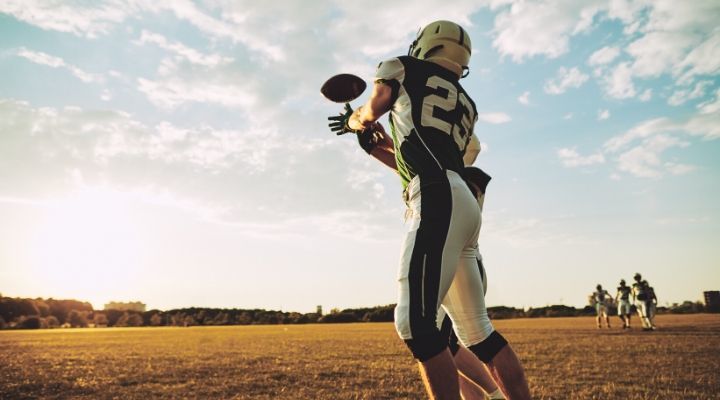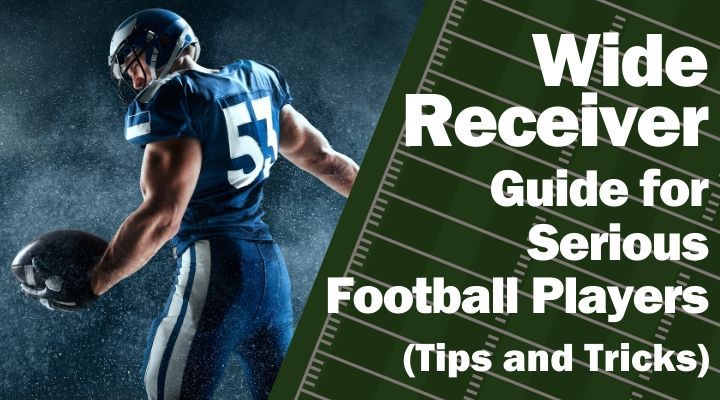When you talk about some of the greatest players to ever play football, the list would almost certainly include Wide Receivers.
Over the years we’ve witnessed countless miraculous catches and amazing touchdowns – most involving wide receivers (or ‘WR’).
Some of the best WRs were also some of the highest-profile players – either for their remarkable skills, their personality, or both.
The list includes the likes of Jerry Rice, Terrell Owens, Randy Moss, Cris Carter, Larry Fitzgerald, Steve Largent, Marvin Harrison, and Michael Irvin.
But what set these players apart from other all the other receivers throughout the history of the sport?
Most people think all it takes to be a great wide receiver is speed to get separation from defenders and good hands to catch the ball.
Although these traits definitely matter, there is so much more to what separates good receivers from the great ones.
If you’re looking to develop your game as a Wide Receiver, here’s our ultimate guide!

What is a Wide Receiver in Football?
Wide receivers are the main targets for quarterbacks when it comes to passing plays.
As the offense lines up for a play, wide receivers will get into their stance usually lining themselves up out wide – hence the name.
At the snap, these players will then run routes and try to create separation from their defenders before eventually catching the pass.
As you would imagine, their main job is to get open and catch the ball when a pass is thrown at them.
Wide receivers are usually tall, quick, and fast – enabling them shake off, out-run, and out-jump their defenders.
However, playing this position goes beyond having great hands and the ability jump high over defenders.
To be a truly great wide receiver, a player must also be tough, able to run crisp routes, and be willing to help out in the running game (because not all plays will be passes).
Wide Receiver Position on the Field
Wide receivers usually line up out wide to either side of the quarterback.
Offenses will usually deploy at least two wide receivers, depending on which play they’ll choose to run.
Teams with a strong passing game may tend to run more plays out of different spread formations, opting to load up on receivers.
While run-heavy offenses may opt to go for more size rather than speed – substituting some receivers for running backs or tight ends.
Receivers will then either run routes and try to get open for a pass, serve as decoys, or help out in the running game.
No matter what play the offense runs, wide receivers play a crucial role on just about every down.
What Does a Wide Receiver Do?
A wide receiver has a wide range of responsibilities.
Here are a few of them:
1. Run Great Routes
The primary role of a wide receiver is to get open on passing plays.
The only way he can make a big impact in the passing game is if he gets open for the quarterback to throw him the ball.
And the only way to get open is to run crisp, effective routes.
All wide receivers must learn the nine basic routes in what's known as the Route Tree.
These are the most common routes that every wide receiver will run -- no matter what team he's playing for and what type of offense they’ll run.
He may be better at running some routes than others, and that's OK.
The important thing is that he learns how the routes are run, and practices them over and over again so that he can run them effectively.
2. Catch the Ball
Running a great route and getting open is only the first step in the process. The next step is catching the football.
If a wide receiver can't catch well and consistently, then this isn't the position for him.
Wide receivers must have the ability to catch the ball, but they also must have the ability to make adjustments.
Not every ball is going to be thrown perfectly to them while they're running their route in stride.
Sometimes, they'll need to reach up, down, left, or right to make the catch. Sometimes, the ball will be thrown hard right at their chest.
Different throws will require the wide receiver to corral the ball in different ways.
At the end of the day, though, all that matters is that he makes the catch successfully.
3. Gain Yardage After the Catch
Running a crisp route is step one. Catching the ball is step two. And gaining yardage after the catch is step three.
A wide receiver will certainly be limited if all he does is catch the ball and then get tackled immediately.
Sure, he can be a reliable target for a quarterback, but truly great wide receivers make huge impacts after they catch the ball.
To do this, they must have great explosion and speed after they make a catch.
They also must be elusive, juking, spinning, and faking defenders out so they can get to open spaces on the field.
And they also must be able to break tackles, shed contact, and remain on their feet.
4. Block When Needed
Some wide receivers are only engaged when it's possible that a ball could be thrown their way.
On running plays, they often take a play off and don't give their best effort.
These players don't become great wide receivers.
To be great at the position, you must work hard on every play, even if there's no chance that you'll be thrown the ball.
To be great at the position, a wide receiver must show the same dedication and effort on running plays as he does on passing plays.
He must learn how to block for his position, which means taking the right angles to shield off defenders from the ball carrier.
6 Wide Receiver Traits
Wide receivers can have a huge impact on the game – and having a set of dynamic wide receivers can prove to be invaluable to a team.
Here are a few traits that separate the best receivers from the rest.
1. Great Athleticism
The word "athletic" is often used to describe wide receivers.
But what exactly does it mean?
For our purposes, we're talking about a combination of being quick, agile, and having great balance.
Wide receivers don't necessarily have to be straight speed demons -- although it certainly doesn't hurt if they're blazing fast.
However, they do need to be quick.
Quickness is what a wide receiver will use more often than speed. It's the trait he'll use to run most of the routes he's asked to run.
Great agility means he's able to make sharp cuts, change direction quickly, and burst off these cuts with power and speed.
Without good balance, a wide receiver would never be able to make those cuts, to adjust his body, and to get in a great position to catch the ball -- all as he's likely fighting off at least some contact from a defender.
2. Great Hands
The saying goes that great wide receivers who can't catch end up playing cornerback.
A player could have all the traits and skills to be a wide receiver, but if he isn't a good pass catcher, then wide receiver isn't the position for him.
At the end of the day, the way a wide receiver will make his biggest impact on the field is by catching passes.
To do this, he must have soft hands. He must have great hand-eye coordination. He must have great concentration.
And he must be able to do all of these things consistently.
3. Very Strong
Wide receiver is a physically demanding position.
On passing routes, wide receivers need to explode with their lower body off the line of scrimmage to create separation from a defender.
Once they do get open and catch a pass, every defender on the field will be attacking him to try to make a tackle.
Wide receivers now must fight off tackle attempts using stiff arms and other brute strength to avoid being taken to the ground.
On running plays, wide receivers will be asked to block.
While it'll be a different kind of blocking than an offensive lineman does -- focused more on taking the right angles than using brute strength to move a huge defensive lineman out of the way -- doing so successfully still takes an impressive amount of upper and lower body strength.
4. Great Stamina
On just about every play, wide receivers will be asked to run at full speed.
On passing plays, wide receivers must run as fast as they can during their designated route to try to make it downfield and get open.
In a typical game, there may be 30-40 pass attempts, but even the greatest receivers may only get thrown the ball on one-third of those plays.
Despite this, great wide receivers will be running hard and fast as if they’re going to be thrown the ball on every play.
Even on running plays, wide receivers must run at top speed to get in the proper position to make a block.
Unlike offensive linemen, wide receivers will need to chase down their blocking assignments on most plays, since the defenders aren't lined up directly opposite them and attacking straight ahead.
Without a lot of stamina, a wide receiver will never be able to make it a full game.
5. Understand Defenses
To be a great wide receiver, you must not only study the playbook to learn your routes and blocking responsibilities, but you must study the game and learn defenses.
Examples:
> 4-3 Defense
> 4-2-5 Defense
> Cover 2 Defense
Great wide receivers don't just run the route they're assigned and then just stop if the play isn't there.
Great wide receivers can recognize a spot on the field where they might be able to get open based on how the defense is reacting to his route.
To be a truly great wide receiver, you must make split-second decisions and adjustments to your route.
If an opening isn't there with your assigned route, you must know how and when you can break it off or adjust to get yourself open.
6. Have Great Relationships with Their Quarterbacks
This isn't so much an innate trait as it is a necessity of playing the position.
A wide receiver's on-the-fly adjustments will only be successful if his quarterback can anticipate and recognize where he’s going.
Great wide receiver-quarterback combinations often know exactly how the other position is going to react in a certain situation, without the need to talk to each other.
The only way to establish this relationship is to spend a lot of time in the film room and the practice field working one-on-one with your quarterback.
It's time that will be well spent.

Best Wide Receivers of All Time
Over the years we’ve witnessed many great wide receivers make unbelievable plays, catches, and touchdowns.
The task of ranking all of them is no easy feat, but here’s my take on the top 10 wide receivers of all time (so far):
1. Jerry Rice
2. Randy Moss
3. Steve Largent
4. Don Hutson
5. Terrell Owens
6. Calvin Johnson
7. Larry Fitzgerald
8. Cris Carter
9. Marvin Harrison
10. Lance Alworth
4 Tips for a Wide Receiver
Here are a few tips if you’re looking to bring your Wide Receiver game to new heights.
1. Work on Your Strength
If you really want to be a great wide receiver, you're going to need to hit the weight room hard. It's imperative that you build a strong lower and upper body.
Lower-body strength will help you explode off the line of scrimmage and out of cuts. Upper-body strength will help you shed defenders, break tackles, and match solid catches.
Building this strength will also help you become faster.
2. Get Soft Hands
In order to make a lot of different catches, you need to have soft hands.
The ball is going to be thrown your way at a high rate of speed.
The only way to catch it successfully is if you're able to "absorb" the throw and not stop it in its tracks.
Much like catching a ball in baseball or receiving a pass in basketball, hockey, or soccer, you need to cradle a football when it's thrown to you.
If you have "hard" hands and not "soft" ones, the effect will be like throwing a football against a hard wall:
It'll bounce right off them.
3. Study the Game
Great wide receivers know where to be at all times.
They study their playbook, of course, to know their routes and all their responsibilities on a given play.
But great wide receivers also study the game to learn what defenders do on most plays.
They learn what’s most likely to happen when a defender reacts in a certain way and how he can use that to his advantage to get open.
The only way to do this is to watch a lot of games, study a lot of film, and ask questions when you have them.
4. Work with Your Quarterback - A Lot
Great wide receivers have great relationships with their quarterbacks.
The two will often know exactly what the other is going to do in certain situations without having to communicate using words or hand signals.
If you want to be a great wide receiver, you need to establish this solid relationship with your quarterback.
Talk to him on a consistent basis in practice, in the film room, and in the locker room so you can get on the same page.

Conclusion
Wide receiver is often considered one of the most flashy football positions, and for good reason.
Wide receivers are often known for their boisterous personalities as much as they are for their outstanding football skills.
Truly great wide receivers are more than just pass catchers, though.
They’re dedicated students of the game, they work hard on various wide receiver drills daily, and they’re committed to giving 100% on every play.
No matter whether they’re the primary passing target, a decoy, or have blocking responsibilities on a running play.




